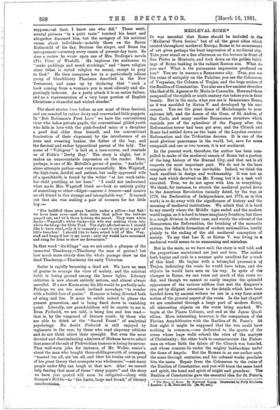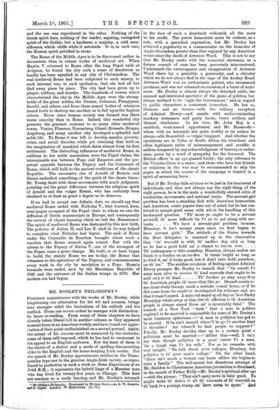MEDLEVAL ROME.* IT was essential that Rome should be included
in the " Mediteval Town Series," but of all the great cities which existed throughout media3val Europa, Rome in its monuments of art gives perhaps the least impression of a mediaaval city. Take your stand on a fine afternoon on the terrace in front of San Pietro in Montcirio, and look down on the golden build- ings of Rome basking in the radiant Roman sun. What do you see ? What is the permanent impression produced on you? You see in essence a Renascence city. True, you see the rains of antiquity on the Palatine, you see the Colosseum of Vespasian, the Column of Trajan, and the huge arches of the Basilica of Constantine. You also see a few ancient churches like that of St. Agnese or St. Maria in Cosmedin. Here and there campanili of the eighth or ninth century rise before you in their beauty. But in the main, what you see is Renascence Rome, as it was moulded by Sixtus V. and developed by his suc- cessors. You see the great dome of Michelangelo to your extreme left, and the domes of the Gest:, of St. Andrea, of San Carlo, and many another Renascence structure which reminds you of the splendour of the Papaoy after the Reformation terror had been got over, and the Church and Rome had settled down on the basis of the Loyolan counter- Reformation and the Tridentine decrees. It is one of the most glorious panoramas in the world, but, save for some campanili and one or two towers, it is not meditevaL In the present work, therefore, the author has been com- pelled to make of the mediaaval annals of Rome but a portion of the long history of the Eternal City, and that not in all respects the most important part. We do not in the least complain of this, for it was inevitable. Indeed, we think the book excellent in design and workmanship. It was not an easy task which devolved on Mr. Young, but it is a task well executed. True, we do not agree with him in everything. We think, for instance, to stretch the mediteval period down to the American Revolution (usually dated, by the way, at 1776, the Declaration of Independence, not 1774, as in this work) is to do away with the significance of history and the meaning of medisaval institutions. We admit that it is hard to say exactly where the Middle Ages ended and the modern world began, as it is hard to trace imaginary frontiers, but there is a rough division in either case, and surely the advent of the Renascence, the Reformation, the breaking of the monastic system, the definite formation of modern nationalities, testify plainly to the ending of the old mediteval conception of society. To say that Leo X. or Sixtus V. was living in a mediaaval world seems to us unmeaning and mistaken.
But in the main, as we have said, the story- is well told, and the proportions maintained are just and true. The author both begins and ends in a manner quite excellent for a work of this kind. He begins with a triumphal processicn of Trojan, indicating the route he would have taken, and the objects he would have seen on his way. In spite of the changes in Rome, we can trace out much of this route to- day, and though we cannot so easily imagine the splendid appearance of the various edifices that met the Emperor's eye, yet by diligent attention to the details which have been handed down by ancient writers we can in a way form some notion of the general aspect of the route. In the last chapter we are conducted through a large part of modern Rome, all interesting objects on the route being marked. We begin at the Piazza Colonna, and end at the Janus Quad- rifons. More interesting, however, is the comparison of the Flavian Amphitheatre with the Basilica of St. Peter's. At first sight it might be supposed that the two could have nothing in common,—one dedicated to the sports of the arena whose huge walls echoed the cries of the martyrs of Christianity; the other built to commemorate the Fisher- man on whose faith the fabric of the Church was founded, and whose remains lie under the mighty baldacchino under the dome of Angelo. But the Roman is, as our auttor say*, the same through centuries, and his colossal works proclaim him the same. Repair from the Colosseum to the ruins of the Basilica of Constantine, and you will trace the same hand and spirit, the hand and spirit of might and grandeur. The Basilica of Constantine gave the essential idea for St. Peter's, 1.0 t saw go. (4e. Od. net, *ALI s!,031.0.aani_al By Norwood Tr. Illustrated by ie1Iy Ericlasah
and the one was reproduced in the other. Nothing of the Greek spirit here, nothing of the tender, aspiring, variegated spirit of the Gothic, but a hardness, a. majesty, a cold mag- nificence, which chills while it astounds. It is, in each case, the Roman spirit petrified in stone.
The Rome of the Middle Ages is to be discovered rather in documents than in extant works of medizeval art. When Martin V. returned to Rome after the long Papal exile at Avignon, he found the city such a scene of desolation as hardly has been equalled in any city of Christendom. The real media3val Rome had been subjected to such misery, to such internal war, to such spoliation, that she had all but died away piece by piece. The city had been given up to plague, robbery, and murder. The hundreds of towers which characterised the city in the Middle Ages were the strong- holds of the great nobles, the Orsinis, Colonnas, Frangipani, Savelli, and others, and from these armed bodies of retainers issued forth to destroy one another, or to fall upon the hapless citizen. Never since human society was formed was there worse anarchy than in Rome. Indeed, this wonderful city presents the greatest contrast to so many other mediteval towns. Venice, Florence, Nuremberg, Ghent, Brussels, Bruges, Augsburg, and many another city developed a splendid and noble life. To Rome it was left to develop squalor, poverty, crime, and social disorder, while yet retaining that hold on the imagination of mankind which dates almost from its first settlement. The disturbing influences of mediteval Rome, in addition to her noble marauders, were the Papal claims, the interminable war between Pope and Emperor, and the per- petual quarrels between the Papacy and the Commune of Rome, which still held to the ancient traditions of the classic Republic. The successive rise of Arnold of Brescia and Rienzi embodied something of the spirit of the classic times. Mr. Young deals with these movements with much judgment, pointing out the great difference between the religious spirit of Arnold and the vulgar Rienzi, who has certainly been idealised to at least as great a degree as he deserves.
If we had to accept one definite date, we should say that media3val Rome ended with Nicholas V., that learned, keen, semi-pagan occupant of the Papal chair to whom we owe the diffusion of Greek manuscripts in Europe, and consequently the revival of classic learning which we call the Renascence. The spirit of mediEeval Rome was destroyed by this new birth. The policies of Julius EL and Leo X. each in its way helped to complete what Nicholas had begun. The sack of Rome under the Constable de Bourbon brought about such a reaction that Rome seemed again ruined. But with the advent to the Papacy of Sixtus V., one of the strongest of the Popes, came a great change. He built, or at least began to build, the stately Rome we see to-day, the Rome that witnesses to the splendour of the Papacy, and commemorates every work in the city by ascription to a Pope. Rome's turmoils were ended, save by the Mazzinian Republic of 1849 and the entrance of the Italian troops in 1870. Her modern era had begun.







































 Previous page
Previous page